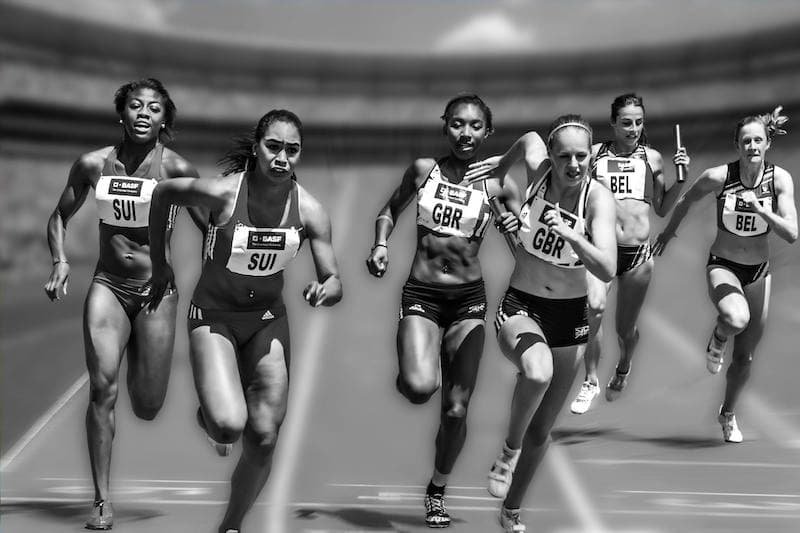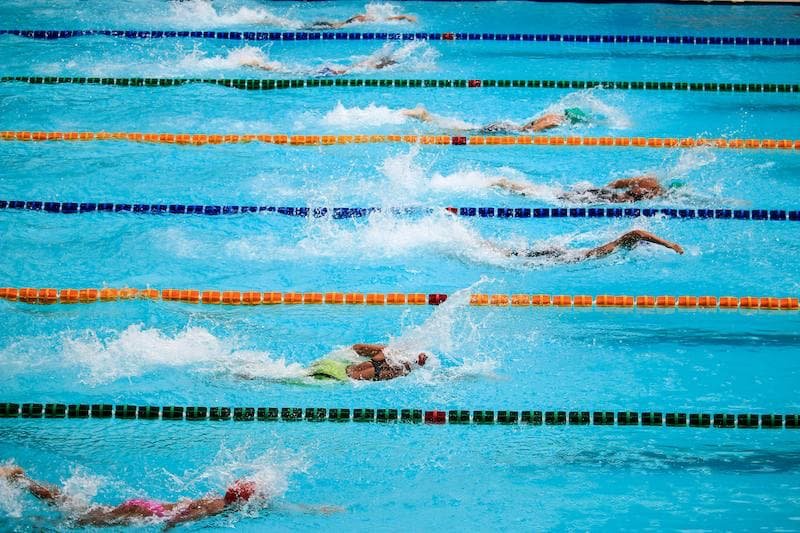
 Katie Wood
Freediver, Writer, Explorer
Katie Wood
Freediver, Writer, Explorer

 Katie Wood
Freediver, Writer, Explorer
Katie Wood
Freediver, Writer, Explorer
In the realm of sports, the journey from an aspiring athlete to a champion is often paved with milestones achieved through strategic goal-setting. From Olympic gold medalists to weekend warriors, the power of setting and pursuing goals is a universal principle that transcends athletic levels and disciplines. In this exploration, we look into the depths of goal-setting in sports, supported by research findings and insights from sports psychologists and coaches alike.
In sports, the significance of goals cannot be overstated. Beyond mere aspirations, goals serve as the guiding stars that illuminate the path toward success for athletes of all levels and disciplines. At its core, the power of goals lies in their ability to provide athletes with direction and purpose. Picture a marathon runner setting their sights on crossing the finish line, a tennis player aiming for a championship title, or a soccer team aspiring to win a league trophy. These goals serve as beacons, rallying athletes around a common objective and galvanizing their efforts toward a shared vision of success.
Yet, the impact of goals extends far beyond mere motivation. Research in sports psychology has consistently demonstrated the profound influence that goal-setting exerts on athlete performance. The seminal work of Locke and Latham (2006) underscored the importance of setting specific, challenging goals, revealing that individuals who do so consistently outperform those with vague or non-existent goals. This finding highlights the transformative power of goals in sharpening athletes' focus and enhancing their commitment to excellence.
Moreover, goals serve as benchmarks against which athletes can measure their progress and gauge their performance. By establishing clear, quantifiable objectives, athletes can track their advancements, celebrate milestones, and identify areas for improvement. This process of self-assessment fosters accountability and self-awareness, empowering athletes to take ownership of their development and strive for continuous growth.
In essence, goals act as catalysts for achievement, propelling athletes beyond their comfort zones and toward the outer limits of their potential. Whether pursuing personal bests, team victories, or championship titles, the act of setting goals imbues athletes with a sense of purpose and drive, fueling their relentless pursuit of excellence.
Moreover, the psychological impact of goal-setting cannot be overstated. Goals serve as psychological scaffolding, providing athletes with a sense of structure and stability amidst the inherent uncertainties of competitive sports. By delineating clear objectives and delineating a path forward, goals instill athletes with confidence, resilience, and a steadfast belief in their ability to overcome obstacles and succeed against the odds.
In essence, goals serve as the foundation upon which athletic greatness is built. They are the compass that guides athletes through the highs and lows of their sporting journeys, the fuel that ignites their passion and determination, and the roadmap that leads them to the pinnacle of success. As athletes harness the transformative power of goals, may they chart a course toward their dreams, fueled by ambition, resilience, and an unwavering commitment to excellence.

Coined by George T. Doran in 1981, the SMART acronym encapsulates the fundamental principles that underpin successful goal-setting: Specific, Measurable, Achievable, Relevant, and Time-bound. Let's delve deeper into each component to unravel the essence of this powerful framework.
Specific: The first pillar of the SMART approach emphasizes the importance of clarity and precision in goal-setting. Specific goals leave no room for ambiguity, clearly articulating what needs to be accomplished and why it matters. For athletes, specificity entails defining their objectives with utmost clarity, whether it's shaving seconds off their sprint time, mastering a new technique, or winning a championship title. By honing in on specific targets, athletes can direct their focus and energy with laser-like precision, maximizing their chances of success.
Measurable: The second dimension of the SMART framework underscores the need for quantifiable criteria to track progress and evaluate success. Measurable goals are tangible and concrete, allowing athletes to gauge their advancements and monitor their performance over time. Whether it's recording personal bests, tracking repetitions, or measuring distances, the ability to quantify progress empowers athletes with invaluable feedback and insights into their journey toward their goals. By establishing measurable benchmarks, athletes can stay accountable, motivated, and on track to achieve their desired outcomes.
Achievable: While ambition is commendable, setting goals that are within reach is paramount for sustained progress and success. The achievable component of the SMART approach encourages athletes to set realistic targets that stretch their capabilities without veering into the realm of impossibility. By striking a delicate balance between ambition and feasibility, athletes can avoid the pitfalls of setting overly lofty goals that may lead to frustration or burnout. Instead, by setting achievable goals, athletes can experience a sense of accomplishment as they steadily progress toward their aspirations, fueling their motivation and confidence along the way.
Relevant: In the dynamic landscape of sports, aligning goals with one's overarching aspirations and values is crucial for meaningful progress and fulfillment. The relevance aspect of the SMART framework prompts athletes to consider the broader context in which their goals are situated, ensuring that they are meaningful and aligned with their aspirations. Whether it's improving performance in a specific aspect of their sport, contributing to team success, or pursuing personal growth, relevance imbues goals with purpose and significance. By anchoring their goals in relevance, athletes can channel their efforts toward endeavors that resonate deeply with their passions and aspirations, driving sustained motivation and engagement.
Time-bound: The final pillar of the SMART approach emphasizes the importance of setting deadlines and timeframes to create a sense of urgency and focus. Time-bound goals provide athletes with a clear timeline within which to work, instilling a sense of accountability and discipline. Whether it's a daily training regimen, a seasonal competition calendar, or a long-term career trajectory, time-bound goals enable athletes to pace their efforts effectively and stay on track toward their desired outcomes. By embracing time-bound goals, athletes can harness the power of momentum and momentum, making steady progress toward their aspirations while staying mindful of the temporal dimension of their journey.

While talent and physical prowess certainly play crucial roles, it is often the strategic approach to goal-setting and execution that sets champions apart from the rest. Here, we explore a range of proven strategies that athletes can employ to enhance their goal-setting endeavors and propel themselves toward greatness.
Visualization: One of the most potent tools in an athlete's toolkit is the power of visualization. Research in sports psychology has consistently demonstrated the efficacy of mental imagery in enhancing performance and bolstering confidence. By vividly picturing themselves achieving their goals – whether it's sinking a game-winning shot, crossing the finish line first, or executing a flawless routine – athletes can prime their minds and bodies for success. Through regular visualization exercises, athletes can cultivate a strong sense of belief in their abilities, heighten their focus, and enhance their readiness to perform at their peak when it matters most.
Breaking Goals into Smaller Tasks: The journey to achieving lofty athletic goals often feels daunting and overwhelming. However, by breaking down big goals into smaller, more manageable tasks, athletes can mitigate feelings of stress and anxiety while maintaining a sense of progress and momentum. This approach, known as "chunking," enables athletes to focus their attention on specific actions or milestones, making the overarching goal feel more attainable and actionable. Whether it's mastering a new skill, improving technique, or enhancing fitness levels, breaking goals into bite-sized tasks empowers athletes to navigate their journey with confidence and clarity.
Goal Prioritization: In the pursuit of athletic excellence, athletes are often inundated with a multitude of goals vying for their attention. To avoid spreading themselves too thin and diluting their efforts, it is essential for athletes to prioritize their goals strategically. By identifying a few key objectives that align closely with their overarching aspirations and focusing their energies on those priorities, athletes can maximize their impact and effectiveness. This targeted approach enables athletes to allocate their time, resources, and attention strategically, ensuring that they make meaningful progress toward their most important goals while maintaining balance and perspective.
Establishing Accountability: While self-motivation is undeniably important, the power of external accountability should not be underestimated. Athletes can enhance their commitment to their goals by enlisting the support of coaches, teammates, or mentors who can hold them accountable for their actions and progress. Whether it's sharing goals with a training partner, scheduling regular check-ins with a coach, or joining a supportive community of like-minded individuals, accountability mechanisms provide athletes with valuable feedback, encouragement, and support. By fostering a culture of accountability, athletes can stay focused, motivated, and accountable to their aspirations, even in the face of adversity.
Adaptability: The path to athletic success is rarely linear, and unforeseen challenges and obstacles are par for the course. To thrive in the ever-changing landscape of competitive sports, athletes must cultivate a mindset of adaptability and resilience. This entails remaining flexible and open to adjusting their goals and strategies in response to changing circumstances, setbacks, or feedback. By embracing change as an opportunity for growth and learning, athletes can navigate obstacles with grace and resilience, emerging stronger and more resilient on the other side. Adaptability enables athletes to pivot, innovate, and thrive in the face of adversity, ultimately propelling them toward their goals with unwavering determination and resilience.

From injuries and setbacks to performance slumps and external pressures, athletes face a myriad of hurdles that can test their resolve and resilience. However, adept goal-setters understand that challenges are not roadblocks but rather opportunities for growth and learning. Here, we explore a range of strategies that athletes can employ to navigate challenges effectively and emerge stronger and more resilient on the other side.
Embracing Failure as a Learning Opportunity: In the pursuit of athletic greatness, failure is not the enemy but rather a natural and inevitable part of the process. Athletes who embrace failure as a learning opportunity – rather than a reflection of their worth or ability – can extract valuable insights and lessons from setbacks, enabling them to grow and improve. By reframing failure as feedback and viewing mistakes as stepping stones toward success, athletes can cultivate a growth mindset – the belief that abilities can be developed through dedication and effort. This mindset empowers athletes to bounce back from setbacks with resilience and determination, ultimately propelling them toward their goals with renewed vigor and perspective.
Cultivating Resilience and Mental Toughness: Resilience – the ability to bounce back from adversity – is a hallmark trait of elite athletes. While resilience may seem like an innate quality, research suggests that it can be cultivated and strengthened over time. Athletes can enhance their resilience by cultivating a range of psychological skills, such as optimism, perseverance, and self-regulation. Techniques such as mindfulness meditation, visualization, and positive self-talk can also bolster athletes' mental toughness, enabling them to maintain focus and composure under pressure. By equipping themselves with these resilience-building tools, athletes can weather the storms of competition with grace and fortitude, emerging stronger and more resilient on the other side.
Seeking Support and Guidance: Athletes need not navigate the challenges of their sporting journey alone. In times of adversity, seeking support and guidance from coaches, teammates, or mentors can provide invaluable comfort, perspective, and encouragement. Whether it's seeking advice on overcoming a performance slump, receiving treatment for an injury, or simply venting frustrations to a sympathetic ear, the power of social support cannot be overstated. By surrounding themselves with a supportive network of individuals who believe in their abilities and share their passion for excellence, athletes can find strength, solace, and inspiration in times of need, enabling them to persevere and thrive in the face of adversity.
Practicing Self-Compassion: In the high-stakes world of sports, athletes often face immense pressure to perform at their best, leading to feelings of self-doubt, criticism, and burnout. In such moments, practicing self-compassion – the act of treating oneself with kindness, understanding, and acceptance – can be a powerful antidote. Athletes can cultivate self-compassion by acknowledging their humanity, embracing imperfection, and reframing setbacks with kindness and empathy. By extending the same level of care and compassion to themselves that they would to a close friend or teammate, athletes can cultivate resilience, self-confidence, and well-being, ultimately enabling them to navigate challenges with grace and resilience.
Staying Committed to the Process: In the face of adversity, it can be tempting for athletes to lose sight of their goals and succumb to feelings of frustration or despair. However, adept goal-setters understand that success is not defined by the absence of challenges but rather by one's ability to persevere in the face of adversity. By staying committed to the process – maintaining a steadfast focus on their goals, trusting in their abilities, and persevering through adversity – athletes can weather the storm of challenges with resilience and determination. In doing so, they not only strengthen their resolve and character but also lay the groundwork for future success and achievement.

Whether it emanates from coaches, teammates, or self-assessment, feedback provides athletes with valuable insights and perspectives that can inform their goal-setting endeavors and propel them toward success. Here, we explore the transformative power of feedback and reflection in the pursuit of athletic excellence.
Seeking Constructive Feedback: Constructive feedback – feedback that is specific, actionable, and delivered with the intention of facilitating growth and improvement – is a cornerstone of athletic development. Athletes can solicit feedback from a variety of sources, including coaches, teammates, and even opponents, to gain diverse perspectives and insights into their performance. By actively seeking out feedback and remaining open to criticism, athletes can identify areas for improvement, refine their skills, and fine-tune their strategies. Moreover, by viewing feedback as an opportunity for growth rather than a judgment of their abilities, athletes can cultivate a mindset of continuous learning and improvement, enabling them to thrive in the competitive arena of sports.
Engaging in Self-Reflection: While external feedback is invaluable, the practice of self-reflection is equally essential for athletes seeking to maximize their potential. Self-reflection involves introspection, self-assessment, and honest evaluation of one's performance, mindset, and behavior. Athletes can engage in self-reflection through techniques such as journaling, visualization, or post-competition debriefs, allowing them to gain clarity on their strengths, weaknesses, and areas for growth. By taking the time to reflect on their experiences, challenges, and successes, athletes can gain valuable insights into their performance, refine their goals, and chart a course toward continued improvement and excellence.
Identifying Patterns and Trends: Feedback and reflection enable athletes to identify patterns and trends in their performance over time, providing valuable data that can inform their goal-setting endeavors. By analyzing feedback from multiple sources and reflecting on their experiences, athletes can identify recurring themes, strengths, and areas for improvement in their performance. This process of pattern recognition empowers athletes to set goals that are informed by evidence and tailored to their unique strengths and weaknesses, maximizing their chances of success. Moreover, by tracking their progress over time and monitoring changes in their performance, athletes can make informed adjustments to their training, tactics, and goals, ensuring that they continue to evolve and grow as athletes.
Implementing Actionable Strategies: Feedback and reflection are only valuable to the extent that they inform action and drive meaningful change. Armed with insights gleaned from feedback and reflection, athletes can develop actionable strategies and plans to address areas for improvement and capitalize on their strengths. Whether it's refining technique, adjusting training routines, or enhancing mental preparation, athletes can leverage feedback and reflection to tailor their approach to goal-setting and performance optimization. By implementing targeted strategies and monitoring their progress, athletes can turn feedback into tangible results, inching closer toward their goals with each deliberate action.
Fostering a Culture of Continuous Improvement: Feedback and reflection are not isolated events but rather ongoing processes that form the bedrock of a culture of continuous improvement. Athletes who prioritize feedback and reflection as integral components of their training and development foster an environment of accountability, growth, and excellence. By embracing feedback as a catalyst for growth and viewing reflection as a pathway to self-awareness and improvement, athletes can cultivate a culture of continuous learning and evolution, propelling themselves and their teammates toward ever-higher levels of performance and achievement.

In the intricate tapestry of athletic achievement, goal-setting stands as a cornerstone, guiding athletes toward their fullest potential. By embracing the science of goal-setting – from the SMART framework to resilience-building strategies – athletes can chart a course toward victory, fueled by passion, determination, and unwavering dedication. As they navigate the twists and turns of their athletic journeys, may they remember that the pursuit of greatness begins with a single step – and a clear, compelling goal in mind.